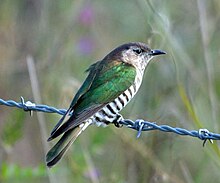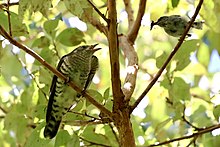Shining bronze cuckoo
| Shining bronze cuckoo | |
|---|---|

| |
| In NSW, Australia | |
| Scientific classification | |
| Domain: | Eukaryota |
| Kingdom: | Animalia |
| Phylum: | Chordata |
| Class: | Aves |
| Order: | Cuculiformes |
| Family: | Cuculidae |
| Genus: | Chrysococcyx |
| Species: | C. lucidus
|
| Binomial name | |
| Chrysococcyx lucidus (Gmelin, 1788)
| |
| Synonyms | |
|
Chalcites lucidus | |
The shining bronze cuckoo (Chrysococcyx lucidus) is a species of cuckoo in the family Cuculidae, found in Australia, Indonesia, New Caledonia, New Zealand, Papua New Guinea, Solomon Islands, and Vanuatu. It was previously also known as Chalcites lucidus.
It is a very small cuckoo, being only 13 to 18 cm (5.1 to 7.1 in) in length, and parasitises chiefly dome-shaped nests of various Gerygone species, having a range that largely corresponds with the distribution of that genus. It may also parasitise other Acanthizidae species, and is also the most southerly ranging brood parasitic bird species in the world, extending to at least 46°S in New Zealand.
Taxonomy[edit]

The shining bronze cuckoo was formally described in 1788 by the German naturalist Johann Friedrich Gmelin in his revised and expanded edition of Carl Linnaeus's Systema Naturae. He placed it with all the other cuckoos in the genus Cuculus and coined the binomial name Cuculus lucidus.[2] Gmelin based his description on the Shining cuckoo from New Zealand that had been described and illustrated in 1782 by the English ornithologist John Latham in his A General Synopsis of Birds. Latham had in turn based his account on a drawing obtained from Joseph Banks.[3] The shining bronze cuckoo is now placed together with 12 other species in the genus Chrysococcyx that was introduced in 1826 by the German zoologist Friedrich Boie.[4][5] The genus name combines the Ancient Greek χρυσος khrusos meaning "gold" with κοκκυξ kokkux "cuckoo". The specific epithet lucidus is from Latin and means "clear" or "bright".[6]
In 1801 Latham described the "Glossy cuckoo" as Cuculus plagosus from New South Wales,[7][8] and the two were classified as separate species for many years. However Latham's Cuculus plagosus is now considered as a subspecies of the shining bronze cuckoo.[9] In New Zealand it is usually known as the shining cuckoo, or by its Māori name pīpīwharauroa.[10]
Formerly some authorities placed the shining bronze cuckoo in the genus Chalcites instead of Chrysococcyx.[11][12]
Four subspecies are recognised:[5]
- C. l. harterti (Mayr, 1932) – resident on Rennell and Bellona (south Solomon Islands)
- C. l. layardi Mathews, 1912 – resident on Temotu (=Santa Cruz Islands, southeast Solomon Islands), Vanuatu including Banks Islands and New Caledonia including Loyalty Islands
- C. l. plagosus (Latham, 1801) – breeds southwest Western Australia, Cape York Peninsula, northeast Queensland to southeast South Australia and Tasmania (southwest, northeast Australia and Tasmania): winters Lesser Sunda Islands, New Guinea and Bismarck Archipelago
- C. l. lucidus (Gmelin, JF, 1788) – breeds North, South, Stewart Island, satellites and Chatham Islands (east of South Island; New Zealand): winters to east Australia, New Guinea, D'Entrecasteaux Archipelago (east of southeast New Guinea), Bismarck Archipelago including Admiralty Islands and Solomon Islands
Description[edit]
Hard to spot and easier to hear, the shining bronze cuckoo is 13–18 cm (5.1–7.1 in) in overall length, has a wingspan of 25–32 cm (9.8–12.6 in) and weighs around 25 g (0.88 oz). It is slightly larger than Horsfield's bronze cuckoo (Chrysococcyx basalis).[13] It has metallic golden or coppery green upperparts and white cheeks and underparts barred with dark green. The female is similar with a more purplish sheen to the crown and nape and bronzer-tinged barring on the belly. The bill is black and the feet are black with yellow undersides.[14]
Distribution and habitat[edit]

The shining bronze cuckoo is a summer visitor to Eastern Australia from the Cape York Peninsula in Queensland to South Australia's Eyre Peninsula and Kangaroo Island and Tasmania, as well as Western Australia from Carnarvon in the north to the southwest and east to Esperance. These winter in the Lessa Sunda Islands and New Guinea.[15] New Zealand populations winter in the Solomon Islands and arrive in New Zealand from mid August, though they are not common until October. They spread out to Stewart and Chatham Islands and are found to an altitude of 4000 ft.[14] The island races, layardi in New Caledonia, Vanuatu and some of the islands of the Solomon Islands, and harterti of Rennell and Bellona Islands in the Solomons, are non-migratory.[12]
Behaviour and ecology[edit]
Breeding[edit]


A female shining bronze cuckoo lays a single egg in a host nest and removes a host egg. After hatching, the baby cuckoo ejects the host nestlings from the nest.[16]
The grey warbler is a common host species in New Zealand, the shining bronze cuckoos missing the first but parasitising heavily the second broods of the season (55% of nests in a study in Kaikōura).[17] Fieldwork near Kaikōura showed that the dark colour of cuckoo eggs seemed to serve to protect cuckoo eggs from being removed by other cuckoos in grey warbler nests rather than the hosts. A test using model eggs of different tones showed that the hosts did not reject eggs, but that cuckoos removed eggs of brighter colours. The dark matte cuckoo eggs are hard to see in the shadows of a grey warbler nest.[18]
The Chatham Island warbler is a host species in the Chatham Islands.[14] The matte eggs laid are olive brown in Western Australia and various shades of green or greenish white to olive to dark brown elsewhere, and do not resemble the eggs of their host. The dark pigment rubs off easily.[16] The eggs are often dark coloured in thornbill and gerygone nests, whose eggs are likewise domed and dark. This is thought to minimise the risk of ejection by a second female cuckoo visitor to the already parasitised nest, which might overlook a dark egg when laying another egg.[17]
Several other species are occasional hosts. In Victoria in 2005, a pair of chestnut-rumped heathwren was encountered with a juvenile shining bronze cuckoo which imitated the alarm call of a baby heathwren.[19] The introduced house sparrow and song thrush have been recorded as hosts in New Zealand.[20]

In New Caledonia, the fan-tailed gerygone (Gerygone flavolateralis) is the sole host of the species.[21]
Food and feeding[edit]
Insectivorous, the shining bronze cuckoo eats insects that are avoided by other birds, such as caterpillars, particularly those of the magpie moth, and beetles, particularly ladybirds. The shining bronze cuckoo's gizzard is lined with a soft thick lining which catches the caterpillar spines; these fall away and are spat out by the bird.[22]
Predators and threats[edit]
The shining bronze cuckoo falls prey to cats. It has been recorded dying after flying into windows.[14]
References[edit]
- ^ BirdLife International (2012). "Chrysococcyx lucidus". IUCN Red List of Threatened Species. 2012. Retrieved 26 November 2013.
- ^ Gmelin, Johann Friedrich (1788). Systema naturae per regna tria naturae : secundum classes, ordines, genera, species, cum characteribus, differentiis, synonymis, locis (in Latin). Vol. 1, Part 1 (13th ed.). Lipsiae [Leipzig]: Georg. Emanuel. Beer. p. 421.
- ^ Latham, John (1782). A General Synopsis of Birds. Vol. 1, Part 2. London: Printed for Benj. White. p. 528, No. 24 Plate 23.
- ^ Boie, Friedrich (1826). "Generalübersicht der ornithologischen Ordnungen, Familien und Gattungen". Isis von Oken (in German). 19. Cols 969–981 [977].
- ^ a b Gill, Frank; Donsker, David; Rasmussen, Pamela, eds. (January 2022). "Turacos, bustards, cuckoos, mesites, sandgrouse". IOC World Bird List Version 12.1. International Ornithologists' Union. Retrieved 14 August 2022.
- ^ Jobling, James A. (2010). The Helm Dictionary of Scientific Bird Names. London: Christopher Helm. pp. 105, 232. ISBN 978-1-4081-2501-4.
- ^ Latham, John (1801). Supplement II to the General Synopsis of Birds. London: Leigh & Sotheby. pp. 138–139.
- ^ Latham, John (1801). Supplementum Indicis Ornithologici sive Systematis Ornithologie Studio et Opera. London: Leigh & Sotheby. p. xxxi. For a discussion of the publication date see: Dickinson, E.C.; Overstreet, L.K.; Dowsett, R.J.; Bruce, M.D. (2011). Priority! The Dating of Scientific Names in Ornithology: a Directory to the literature and its reviewers. Northampton, UK: Aves Press. pp. 115–116. ISBN 978-0-9568611-1-5.
- ^ Christidis, Les; Boles, Walter (2008). Systematics and taxonomy of Australian birds. Collingwood, VIC, Australia: CSIRO Pub. p. 162. ISBN 978-0-643-06511-6.
- ^ "Shining cuckoo | New Zealand Birds Online". nzbirdsonline.org.nz. Retrieved 2020-05-09.
- ^ Peters, James Lee, ed. (1940). Check-List of Birds of the World. Vol. 4. Cambridge, Massachusetts: Harvard University Press. p. 32.
- ^ a b Payne, R. (2019). del Hoyo, Josep; Elliott, Andrew; Sargatal, Jordi; Christie, David A; de Juana, Eduardo (eds.). "Shining Bronze-cuckoo (Chalcites lucidus)". Handbook of the Birds of the World Alive. Barcelona: Lynx Edicions. Retrieved 21 February 2019.
- ^ Higgins 1999, p. 726.
- ^ a b c d Falla, Robert Alexander; Sibson, Richard Broadley; Turbott, Evan Graham (1972) [1966]. The New Guide to the Birds of New Zealand. Collins. pp. 181–82. ISBN 0-00-212022-4.
- ^ Sibley, Charles Gald; Monroe, Burt Leavelle (1990). Distribution and Taxonomy of Birds of the World. Yale University Press. p. 100. ISBN 0300049692.
- ^ a b Johnsgard, Paul A. (1997). The Avian Brood Parasites:Deception at the Nest: Deception at the Nest. Oxford University Press. p. 233. ISBN 0195110420.
- ^ a b Davies, Nick (2010). Cuckoos, Cowbirds and Other Cheats. A&C Black. p. 94. ISBN 978-1408135860.
- ^ Thorogood, Rose; Kilner, Rebecca M.; Rasmussen, Justin (2017). "Grey Gerygone hosts are not egg rejecters, but Shining Bronze-Cuckoos lay cryptic eggs". The Auk. 134 (2): 340–49. doi:10.1642/AUK-16-128.1.
- ^ Rogers, Danny I; Rogers, Ken G.; Sandbrink, Joan (2006). "Shining Bronze-Cuckoo associating with and imitating alarm call of Chestnut-rumped Heathwren". Australian Field Ornithology. 23 (1): 42–45. ISSN 1448-0107.
- ^ Smith, W.W. (1931). "Feeding habits of the Shining Bronze Cuckoo" (PDF). Emu. 30 (3): 217–18. doi:10.1071/mu930217.
- ^ Attisano, Alfredo; Thiel, Felix; Sato, Nozomu; Okahisa, Yuji; Bolopo, Diana; Tanaka, Keita D.; Kuehn, Ralph; Gula, Roman; Ueda, Keisuke; Theuerkauf, Jörn (28 August 2018). "Breeding biology of the Fan-tailed Gerygone Gerygone flavolateralis in relation to parasitism by the Shining Bronze-cuckoo Chalcites lucidus". Journal of Ornithology. 160 (1): 91–103. doi:10.1007/s10336-018-1592-6.
- ^ Gill, Brian J. (1980). "Foods of the Shining Bronze Cuckoo (Chrysococcyx lucidus, Aves, Cuculidae) in New Zealand" (PDF). New Zealand Journal of Ecology. 3: 138–140.
Sources[edit]
- Higgins, P.J., ed. (1999). "Chrysococcyx lucidus Shining Bronze-Cuckoo" (PDF). Handbook of Australian, New Zealand & Antarctic Birds. Vol. 4, Parrots to dollarbird. Melbourne, Victoria: Oxford University Press. pp. 726–744. ISBN 978-0-19-553071-1.


